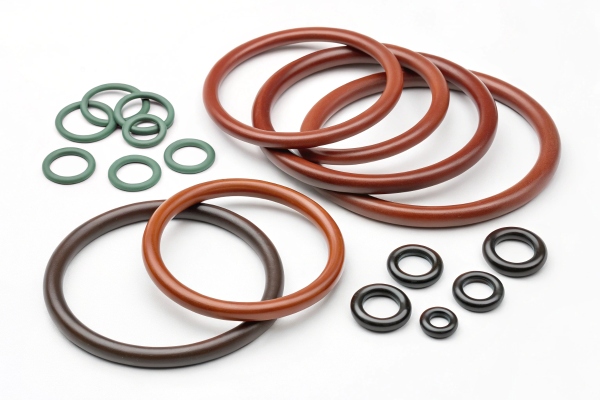Rubber gaskets play a crucial role in ensuring that seals remain intact under extreme temperatures. Without the right materials, machinery can experience leaks, inefficiency, and even breakdowns.
High-temp rubber gaskets are essential in industries that experience extreme heat. They maintain seal integrity, preventing leaks and ensuring smooth operations.
Let’s explore why certain rubber materials are critical for high-temperature environments and which types are best suited for the job.
What Rubber Gasket for High Temperature?
Rubber gaskets for high temperatures are specially designed to withstand heat stress. When exposed to high temperatures, the material needs to retain its sealing properties to prevent leakage and system failure.
High-temp rubber gaskets must endure thermal stress and maintain their sealing abilities to prevent leaks and damage.
Types of Rubber Gaskets for High Temperature
Different types of rubber gaskets perform better under specific conditions. Materials like silicone1, EPDM2, and Viton3 have different heat resistance capabilities. Let’s break down the best options available:
| Rubber Type | Temperature Range | Best for |
|---|---|---|
| Silicone | -60°C to 300°C | Food, pharmaceutical, automotive |
| EPDM | -50°C to 150°C | Outdoor, automotive, HVAC |
| Viton | -10°C to 250°C | Chemical, oil-resistant seals |
| Nitrile | -30°C to 120°C | Oil sealing, moderate heat applications |
Each of these materials has its strengths and weaknesses, depending on the specific requirements of your application. Silicone, for instance, is fantastic for extremely high temperatures, but it’s more flexible and less resistant to certain chemicals. Viton, on the other hand, is excellent for oil and chemical resistance but has a more limited temperature range.
Choosing the Right Gasket Material
When selecting the right gasket for high temperatures, consider the following factors:
- Temperature Range: Ensure that the gasket can handle the maximum temperature of your environment.
- Chemical Exposure: Some gaskets, like Viton, are better at resisting chemicals.
- Flexibility: Materials like silicone offer flexibility and can withstand extreme temperature swings.
- Durability: For high-stress environments, materials like EPDM offer a good balance of durability and temperature resistance.
What is the Best Rubber for High Temperatures?
The best rubber for high-temperature applications depends on your specific needs. Silicone is one of the most heat-resistant rubbers, but it may not be suitable for every situation.
Silicone rubber is often the best choice for high-temperature sealing, but EPDM and Viton are also strong contenders depending on other requirements.
Advantages of Silicone Rubber
Silicone rubber is well-known for its excellent temperature resistance. It can endure temperatures ranging from -60°C to 300°C, making it perfect for industries that require sealing under extreme conditions.
Key Benefits of Silicone Rubber
- Wide Temperature Range: Can endure high temperatures without losing integrity.
- Flexibility: Silicone remains flexible and maintains its sealing ability even in extreme conditions.
- Non-Toxic: Suitable for food and medical applications due to its non-toxic nature.
Silicone rubber is often used in industries like food processing, medical devices, and automotive manufacturing. Its ability to maintain its properties at high temperatures makes it an essential material in these sectors.
When Should You Use Silicone Rubber?
Silicone rubber is ideal when you need a gasket that can handle high temperatures for extended periods. It’s commonly used in high-temperature ovens, HVAC systems, and food processing equipment. However, it does come with a higher price tag compared to other materials, so you need to consider whether the performance benefits outweigh the cost.
Comparing Silicone to Other Rubber Types
Silicone rubber has the upper hand when it comes to heat resistance. However, materials like EPDM and Viton are also great options, depending on the application.
| Rubber Type | Max Temperature | Benefits |
|---|---|---|
| Silicone | 300°C | Excellent heat resistance, flexible |
| EPDM | 150°C | Good for outdoor use, weather resistant |
| Viton | 250°C | Oil and chemical resistant |
Silicone outperforms other rubbers in extreme heat environments, but if you also need resistance to oils or chemicals, Viton may be a better choice. EPDM is more cost-effective but is not suitable for the highest heat levels.
What is the Temperature Limit for EPDM Rubber?
EPDM rubber typically has a temperature limit between -50°C to 150°C. While it’s excellent for outdoor and automotive applications, it’s not suitable for environments that require higher temperatures.
EPDM rubber can handle temperatures from -50°C to 150°C, making it ideal for most automotive and HVAC applications.
EPDM's Strengths and Limitations
EPDM is an excellent option for sealing in outdoor environments, HVAC systems, and vehicles. It resists weathering, ozone, and UV degradation, which makes it a popular choice for seals exposed to the elements.
Key Benefits of EPDM
- Weather Resistance: Excellent in outdoor applications due to resistance to UV and ozone.
- Flexibility: EPDM maintains its flexibility even at low temperatures.
- Cost-Effective: Compared to silicone and Viton, EPDM is more affordable.
However, its temperature range is limited, making it unsuitable for high-heat environments.
When to Use EPDM Rubber?
EPDM is ideal for applications where high heat is not a concern. It is often used for sealing in automotive systems, HVAC applications, and construction where it will face the elements but not extreme temperatures.
What industries rely most on high-temperature gaskets?
High-temperature gaskets are critical components across various industries where extreme thermal conditions are prevalent. The following sectors rely heavily on these specialized sealing solutions:
1. Automotive Industry
- Applications: High-temperature gaskets are used in engine components, exhaust systems, and turbochargers. They prevent leaks of gases and fluids, ensuring optimal performance under the high temperatures generated during operation.
2. Aerospace Industry
- Applications: In aerospace, these gaskets are essential for jet engines, heat shields, and insulation systems. They must withstand extreme temperatures experienced during flight, ensuring the safety and reliability of aircraft components.
3. Oil and Gas Industry
- Applications: High-temperature gaskets are utilized in pipelines, valves, and pressure vessels that operate under high temperatures and pressures. Their durability is crucial for preventing leaks in harsh environments.
4. Power Generation
- Applications: These gaskets are critical in power plants, particularly in turbines and boilers, where they manage high heat and pressure while maintaining system integrity.
5. Chemical Processing
- Applications: In chemical manufacturing, high-temperature gaskets are used in reactors and other equipment that handle aggressive substances at elevated temperatures. Their chemical resistance is vital for safe operations.
6. Industrial Manufacturing
- Applications: High-temperature gaskets are employed in industrial ovens and furnaces to provide effective sealing that prevents heat loss and improves energy efficiency.
7. Food Processing
- Applications: In the food industry, these gaskets are used in cooking equipment such as ovens and steamers to ensure tight seals that maintain temperature and pressure during food preparation processes.
High-temperature gaskets play an indispensable role in various industries by providing reliable sealing solutions necessary for safe and efficient operations under extreme conditions. Their application spans automotive, aerospace, oil and gas, power generation, chemical processing, industrial manufacturing, and food processing sectors.
Conclusion
Choosing the right high-temp rubber gasket is crucial to ensuring long-term performance in extreme environments. Silicone, EPDM, and Viton each offer unique advantages depending on temperature, flexibility, and chemical resistance. Selecting the appropriate material can prevent leaks, reduce downtime, and extend equipment lifespan, ensuring operational efficiency in demanding conditions.
Footnotes
-
Silicone rubber can withstand high temperatures up to 300°C and is ideal for food, medical, and automotive industries due to its heat resistance and flexibility. ↩
-
EPDM rubber is great for outdoor applications with temperature resistance ranging from -50°C to 150°C, ideal for automotive, HVAC, and construction industries. ↩
-
Viton rubber is highly resistant to heat, chemicals, and oils, making it a good option for high-temperature industrial applications, particularly when oil and chemical exposure is involved. ↩









